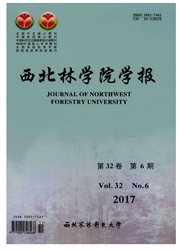

 中文摘要:
中文摘要:
在内蒙古大兴安岭地区,以杜香—兴安落叶松林为研究对象,通过计算不同龄组林下植被各层次及各器官生物量分配,为准确估算森林的固碳能力提供依据。结果表明:杜香—兴安落叶松林从幼龄林到成熟林,林下植被生物量变化范围为19.80-43.96t·hm^-2,其中,枯落物层(69.64%-92.98%)〉灌木层(5.01%-20.82%)〉草本层(1.46%-9.54%)〉苔藓层(0-1.15%)。林分年龄影响着林下植被各层次生物量及其比例,随龄组增加,枯落物量逐渐增加,灌木层生物量呈“U”型;草本层生物量所占比例呈降低趋势。相关分析表明,灌木层生物量与乔木层生物量及林分郁闭度呈负相关关系,凋落物现存量与乔木层和植被总生物量呈极显著正相关。
 英文摘要:
英文摘要:
Taking the Larix gmelinii growing in Daxing'anling mountaineous area in Inner Mongolia region as the research object,biomasses of different vegetation layers and organs of understory vegetation in different age groups were calculated and compared to provide basis for accurate estimation of forest carbon sequestration. It was found that the vegetation biomasses ranged from 19.80 to 43.96 t ·hm^-2 from young forest to mature forest. The proportions of all layers were in the order of litter layer (69.64%-92.98%) 〉 shrub layer (5.01%-20.82%) 〉 herbaceous layer (1.46%-9.54%) 〉moss layer (0-1. 15%). Forest stand ages had different influences on all layers and the proportion of the organs in understory vegetation. With the increase of ages, litter quantity increased gradually, leave, stems, roots and total biomass of shrub layer showed a U-shaped trend,and the proportion of herb layer biomass decreased. Correlation analysis showed that the arbor layer biomass and forest crown density exhibited a negative correlation with understory vegetation biomass; litter standing crop was significantly and positively correlated with tree layer and total vegetation biomass.
 同期刊论文项目
同期刊论文项目
 同项目期刊论文
同项目期刊论文
 期刊信息
期刊信息
